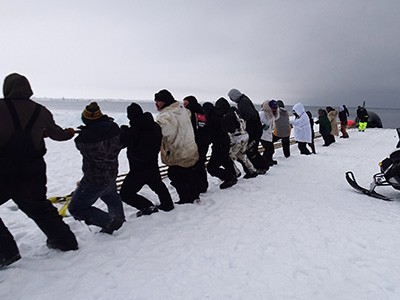USU-led Interdisciplinary Approach Reveals Key to Community Viability
Utqiagvik, Alaska residents haul a harvested bowhead whale from the Beaufort Sea. USU researcher Jacopo Baggio reports how a community shares resources may be more important to the group's well-being than resource abundance. Photo by Jenny K. Evans.
How a community shares declining resources may ultimately be more important to the group’s well-being than resource abundance. Those are findings of a recent study conducted by an interdisciplinary team including Utah State University researcher Jacopo Baggio.
The findings are intriguing, but even more novel, he says, is the collaborative nature of the process that led to the discovery. With colleagues Alex Arenas and Manlio De Domenico of Spain’s Rovira i Virgili University and Shauna BurnSilver of Arizona State University, Baggio, a social-ecological systems modeler, integrated “an amazing data set with very nuanced and advanced mathematical tools.”
The team, with anthropologists James Magdanz and Gary Kofinas of the University of Alaska Fairbanks, published research findings in the Nov. 16, 2016, Early Edition of the Proceedings of the National Academy of Sciences. Their work was supported by the National Science Foundation, the U.S. Department of the Interior and the European Commission on Future and Emerging Technologies-Proactive project.
“Understanding human interactions with the environment is a challenge, but mathematical tools that have emerged in the last decade are helping us decipher the complex, multi-layered web of relationships,” says Baggio, assistant professor in USU’s Department of Environment and Society and the USU Ecology Center, who was lead author on the paper.
The study focused on three indigenous Alaskan coastal communities, which rely on subsistence hunting and fishing, along with the cash economy. The researchers found households within the communities depend on complex networks of social relationships to share food, labor and equipment.
BurnSilver, Magdanz and Kofinas carefully studied the communities for more than three years and amassed critical data, but they needed to reach beyond their expertise to analyze it. Baggio and physicists De Domenico and Arenas designed and implemented a model that preserved the complexity of multiple relationships within the study’s communities and allowed the researchers to examine the effect of social changes versus climatic and resource abundance changes on community connectivity.
“All parts of our study benefitted from this interdisciplinary collaboration,” De Domenico says. “Our daily discussions often switched from applied mathematics to the real impact of climate change on humankind.”
The innovative approach opens the door to new knowledge about the impacts of climatic and environmental change on communities, he says. “Our model and our methodology have been able to face some theoretical challenges in the study of how social and ecological systems interact with and affect each other. Our work has the potential to foster more quantitative analyses in the future.”
Baggio says the project demonstrates how an interdisciplinary approach allows researchers to “push the boundaries of science.”
“We can document, for example, loss of land or key animal species,” he says. “But this level of interdisciplinary integration sheds light on complex interdependencies between people and their rapidly changing environment.”
Related Links
USU Department of Environment and Society
USU Ecology Center
USU Quinney College of Natural Resources
Contact: Jacopo Baggio, 435-797-5747, jacopo.baggio@usu.edu
Writer: Mary-Ann Muffoletto, 435-797-3517, maryann.muffoletto@usu.edu
A social-ecological systems modeler, Jacopo Baggio of USU's Department of Environment and Society and the USU Ecology Center, collaborated with anthropologists and physicists to study complex social interactions within indigenous Alaskan communities.
TOPICS
Community 446stories Ecology 173stories Climate 151stories Discoveries 48storiesComments and questions regarding this article may be directed to the contact person listed on this page.








